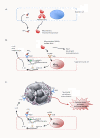How tissue injury alarms the immune system and causes a systemic inflammatory response syndrome
- PMID: 22788849
- PMCID: PMC3488542
- DOI: 10.1186/2110-5820-2-27
How tissue injury alarms the immune system and causes a systemic inflammatory response syndrome
Abstract
Systemic inflammation is very prevalent among critically ill patients, particularly those with extensive tissue injury. Although downstream mediators (cytokines) and effector cells (phagocytes) have been identified, proximal mediators originating from injured tissues remained elusive. Alarmins ("danger signals") released by necrotic/injured cells have been identified recently and certainly play a role in triggering local and systemic inflammation in critically ill patients. The most promising alarmin candidates are of mitochondrial origin, i.e. mitochondrial DNA and the chemotactic factor fMet-Leu-Phe (fMLP). ATP also is released from necrotic tissues and stimulates the assembly of the inflammasome, leading to the production of proinflammatory cytokines, such as interleukin (IL)-1ß. The identification of novel alarmins opens new therapeutic avenues for the treatment of severe SIRS, and SIRS-dependent organ dysfunction.
Figures

References
LinkOut - more resources
Full Text Sources

